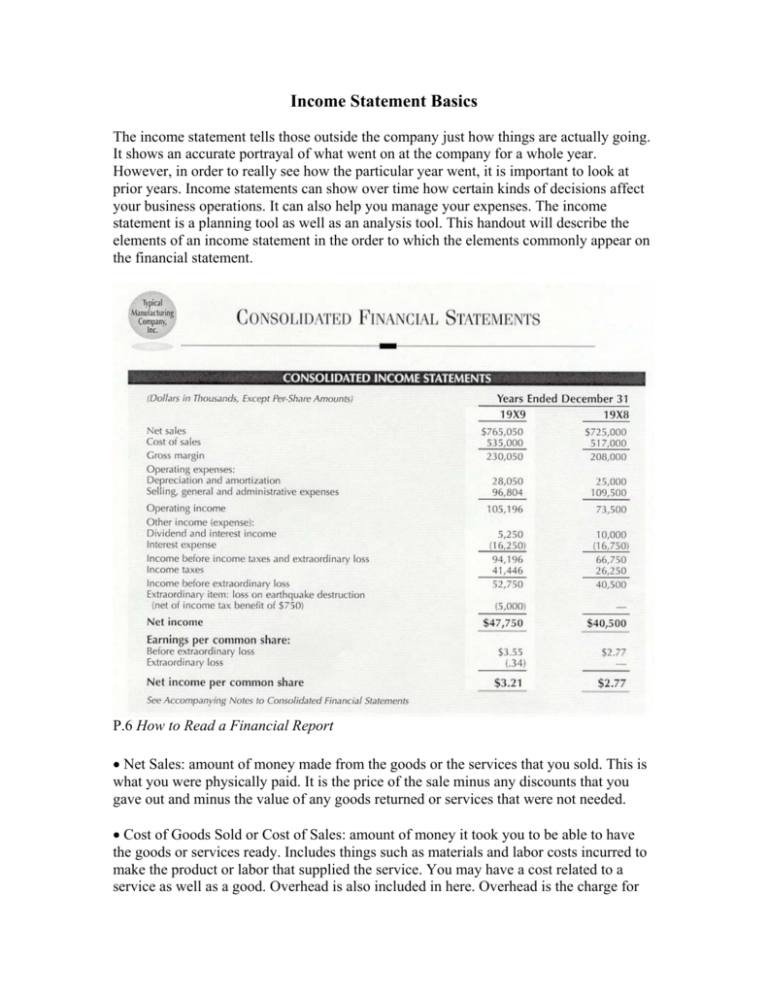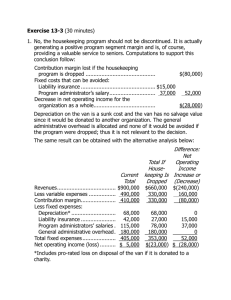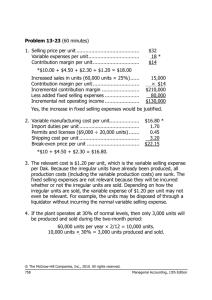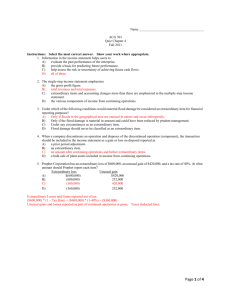Income Statement Basics
advertisement

Income Statement Basics The income statement tells those outside the company just how things are actually going. It shows an accurate portrayal of what went on at the company for a whole year. However, in order to really see how the particular year went, it is important to look at prior years. Income statements can show over time how certain kinds of decisions affect your business operations. It can also help you manage your expenses. The income statement is a planning tool as well as an analysis tool. This handout will describe the elements of an income statement in the order to which the elements commonly appear on the financial statement. P.6 How to Read a Financial Report • Net Sales: amount of money made from the goods or the services that you sold. This is what you were physically paid. It is the price of the sale minus any discounts that you gave out and minus the value of any goods returned or services that were not needed. • Cost of Goods Sold or Cost of Sales: amount of money it took you to be able to have the goods or services ready. Includes things such as materials and labor costs incurred to make the product or labor that supplied the service. You may have a cost related to a service as well as a good. Overhead is also included in here. Overhead is the charge for miscellaneous product costs. For example, when you buy a basketball you are paying for the material, labor, and a small portion of the electrical bill and scrap disposal at the factory. It may be only a few cents of a product or service cost to pay overhead, but it is a cost that the business incurs and must pass on to the consumer. The overhead is spread out over the cost of units produced or services amount and is usually not the majority of the cost. A) Direct Materials: goes into and becomes part of the product that is sold. B) Direct Labor: is used specifically in the production of the product or performance of the service. C) Overhead: a category of various general things that are indirectly used to make a product such as oil for machine parts to keep the factory working. It is usually a small part of each products cost. •Gross Margin: a calculation area on the income statement. The value is Net sales – Cost of sales. This shows how much money you receive compared to what it cost to made the good or service. The gross margin shows you how much money you have available to pay your expenses and still make a profit. •Depreciation and Amortization: subtraction from the value of asset because of wear over time. These are figured out based on the life of an asset or how much it is used. A common way to calculate it is to estimate how much an asset will be worth at the end of its usefulness to you. Subtract the estimated ending value of the asset (Some assets will have no value while some can have value by being resold or scrapped) from what you paid for the asset. This amount needs to be allocated over the amount of time that you feel the asset will be useful to you. There are various methods to calculate this, and it is based on estimates that may need to change or be adjusted. •Selling and Administrative Expenses: costs involved in getting the product or service ready to sell that are not directly related to the product itself. It includes salaries for people not directly involved with the making of the product or performance of the service, advertising, office expenses, etc. Research and development costs are usually included in this section. •Operating Income: income from selling your product or service minus the cost to make the good or service directly, and minus costs associated with running the particular type of business. It can also be thought of as gross margin – expenses incurred to operate your business. This reveals the amount your company has left over after paying it’s own costs to function as a business entity. •Dividend and Interest Income: additional money that you receive from ownership and investments externally. Dividends are your portion of another company’s earnings. Interest income is money that you make as a result of allowing someone else to borrow money from you. It is safety money in the event that your business is not profitable in one year. It allows a business to rely on sources outside of its self. •Interest expense: money you need to pay others because of your borrowing. You get to subtract this out of the money that your company has before calculating the amount of taxes that you have to pay. •Income Before Taxes and Extraordinary Items: all income and expenses without any extraordinary items. This is a summation of the fields already mentioned in this handout. The extraordinary items are listed as a separate line item with their own tax impact after this calculation. Most small businesses will not need to worry about extraordinary items. It would be unreasonable to include them in with regular income because they can dramatically throw figures off and be misleading to your financial information. • Income taxes: the amount you will have to pay in taxes as a result of your income applied to the appropriate tax amount. • Extraordinary items: unusual and infrequent items that probably will never happen to your business again. This is separated out with tax effects because it can deter from what happened and make the income incomparable to prior years. An example would be an earthquake in an area where there had not been any earthquakes before. Large accidents that are unforeseeable are also included in this section. Make sure that you do not include things that are frequent. Floods, fires, strikes, and freezing crops happen in some areas quite a bit and would not be considered extraordinary. • Net Income: may be a positive or negative value. At the end of all things this is what most people look at. This includes all sources of income and all costs. • Footnotes - a written explanation of information that readers of financial statements should be aware of. Many things are required to be in the footnotes, while others are included to make the financial statement more understandable. Large amounts of money spent on research and development, significant ownership in another company, and subsidiary information should be in the footnotes. Any information not conveyed directly in the financial statement that would change the way a person viewed your company should be disclosed in the footnotes. Other additional materials may be included depending on the type of business that the financial statement is devised for. Additional subdivisions and explanations should be included as necessary to make the information more useful. Professionals in the accounting field are able to guide you through this process. Reference: Merrill Lynch. (2003). How to Read a Financial Report.





